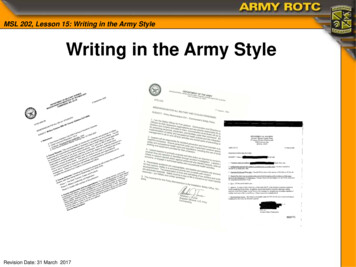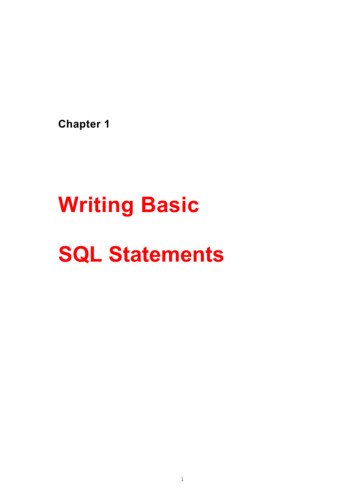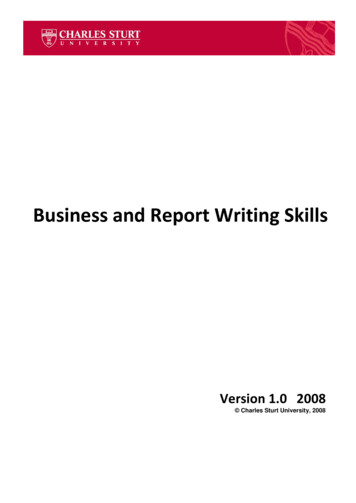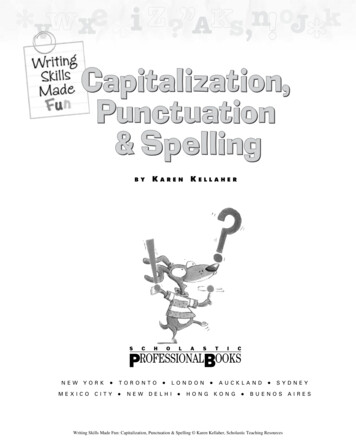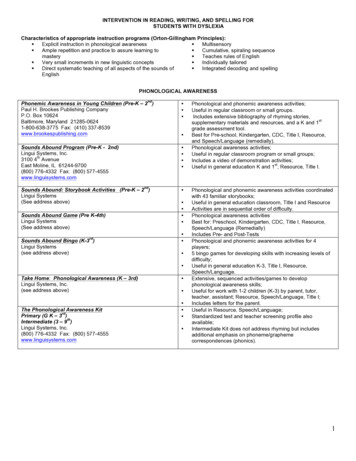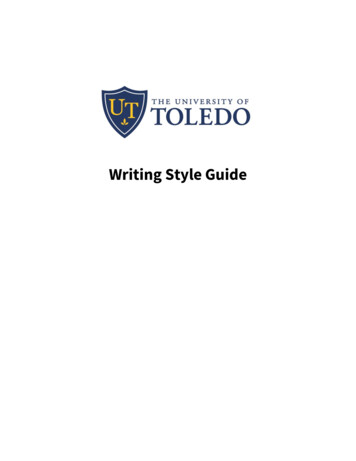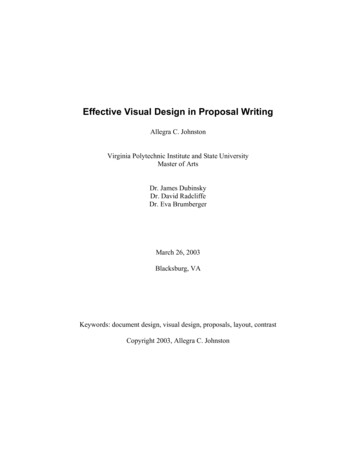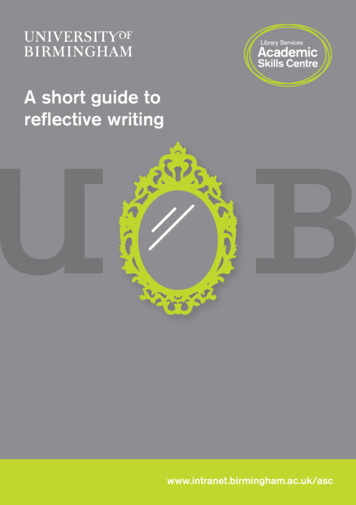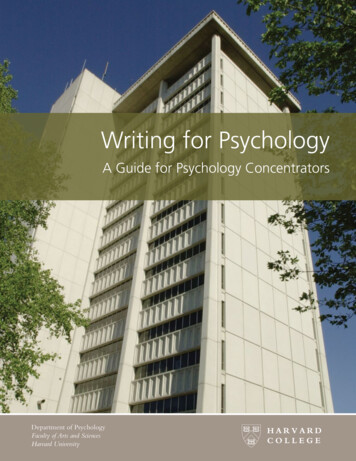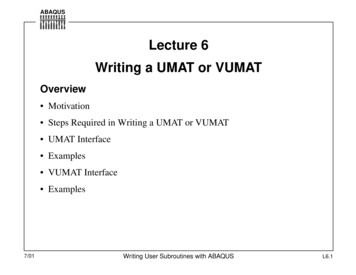
Transcription
ABAQUSLecture 6Writing a UMAT or VUMATOverview Motivation Steps Required in Writing a UMAT or VUMAT UMAT Interface Examples VUMAT Interface Examples7/01Writing User Subroutines with ABAQUSL6.1
ABAQUSOverviewOverview ABAQUS/Standard and ABAQUS/Explicit have interfaces that allowthe user to implement general constitutive equations.– In ABAQUS/Standard the user-defined material model isimplemented in user subroutine UMAT.– In ABAQUS/Explicit the user-defined material model isimplemented in user subroutine VUMAT. Use UMAT and VUMAT when none of the existing material modelsincluded in the ABAQUS material library accurately represents thebehavior of the material to be modeled.7/01Writing User Subroutines with ABAQUSL6.2
ABAQUSOverview These interfaces make it possible to define any (proprietary)constitutive model of arbitrary complexity. User-defined material models can be used with any ABAQUSstructural element type. Multiple user materials can be implemented in a single UMAT or VUMATroutine and can be used together.In this lecture the implementation of material models in UMAT or VUMATwill be discussed and illustrated with a number of examples.7/01Writing User Subroutines with ABAQUSL6.3
ABAQUSMotivationMotivation Proper testing of advanced constitutive models to simulateexperimental results often requires complex finite element models.– Advanced structural elements– Complex loading conditions– Thermomechanical loading– Contact and friction conditions– Static and dynamic analysis7/01Writing User Subroutines with ABAQUSL6.4
ABAQUSMotivation Special analysis problems occur if the constitutive model simulatesmaterial instabilities and localization phenomena.– Special solution techniques are required for quasi-static analysis.– Robust element formulations should be available.– Explicit dynamic solution algorithms with robust, vectorizedcontact algorithms are desired. In addition, robust features are required to present and visualize theresults.– Contour and path plots of state variables.– X–Y plots.– Tabulated results.7/01Writing User Subroutines with ABAQUSL6.5
ABAQUSMotivation The material model developer should be concerned only with thedevelopment of the material model and not the development andmaintenance of the FE software.– Developments unrelated to material modeling– Porting problems with new systems– Long-term program maintenance of user-developed code7/01Writing User Subroutines with ABAQUSL6.6
ABAQUSMotivation “Finite Element Modelling of the Damage Process in Ice,”R. F. McKenna, I. J. Jordaan, and J. Xiao, ABAQUS Users’ ConferenceProceedings, 1990.7/01Writing User Subroutines with ABAQUSL6.7
ABAQUSMotivation “The Numerical Simulation of Excavations in Deep Level Mining,”M. F. Snyman, G. P. Mitchell, and J. B. Martin, ABAQUS Users’Conference Proceedings, 1991.7/01Writing User Subroutines with ABAQUSL6.8
ABAQUSMotivation “Combined Micromechanical and Structural Finite Element Analysis ofLaminated Composites,” R. M. HajAli, D. A. Pecknold, and M. F.Ahmad, ABAQUS Users’ Conference Proceedings, 1993.7/01Writing User Subroutines with ABAQUSL6.9
ABAQUSMotivation “Deformation Processing of Metal Powders: Cold and Hot IsostaticPressing,” R. M. Govindarajan and N. Aravas, private communication,1993.7/01Writing User Subroutines with ABAQUSL6.10
ABAQUSMotivation “Macroscopic Shape Change and Evolution of CrystallographicTexture in Pre-textured FCC Metals,” S. R. Kalidindi and Anand, ActaMetallurgica, 1993.7/01Writing User Subroutines with ABAQUSL6.11
ABAQUSSteps Required in Writing a UMAT or VUMATSteps Required in Writing a UMAT or VUMAT Proper definition of the constitutive equation, which requires one of thefollowing:– Explicit definition of stress (Cauchy stress for large-strainapplications)– Definition of the stress rate only (in corotational framework) Furthermore, it is likely to require:– Definition of dependence on time, temperature, or field variables– Definition of internal state variables, either explicitly or in rateform7/01Writing User Subroutines with ABAQUSL6.12
ABAQUSSteps Required in Writing a UMAT or VUMAT Transformation of the constitutive rate equation into an incrementalequation using a suitable integration procedure:– Forward Euler (explicit integration)– Backward Euler (implicit integration)– Midpoint method7/01Writing User Subroutines with ABAQUSL6.13
ABAQUSSteps Required in Writing a UMAT or VUMATThis is the hard part! Forward Euler (explicit) integration methods aresimple but have a stability limit, ε ε stab,where ε stab is usually less than the elastic strain magnitude.– For explicit integration the time increment must be controlled.– For implicit or midpoint integration the algorithm is morecomplicated and often requires local iteration. However, there isusually no stability limit.– An incremental expression for the internal state variables must alsobe obtained.7/01Writing User Subroutines with ABAQUSL6.14
ABAQUSSteps Required in Writing a UMAT or VUMAT Calculation of the (consistent) Jacobian (required forABAQUS/Standard UMAT only). For small-deformation problems (e.g., linear elasticity) orlarge-deformation problems with small volume changes (e.g., metalplasticity), the consistent Jacobian is σC ---------- , εwhere σ is the increment in (Cauchy) stress and ε is theincrement in strain. (In finite-strain problems, ε is anapproximation to the logarithmic strain.)– This matrix may be nonsymmetric as a result of the constitutiveequation or integration procedure.– The Jacobian is often approximated such that a loss of quadraticconvergence may occur.7/01Writing User Subroutines with ABAQUSL6.15
ABAQUSSteps Required in Writing a UMAT or VUMAT– It is easily calculated for forward integration methods (usually theelasticity matrix).– If large deformations with large volume changes are considered(e.g., pressure-dependent plasticity), the exact form of theconsistent Jacobian1 ( Jσ )C --- -----------------J εshould be used to ensure rapid convergence. Here, J is thedeterminant of the deformation gradient.7/01Writing User Subroutines with ABAQUSL6.16
ABAQUSSteps Required in Writing a UMAT or VUMAT Hyperelastic constitutive equations– Total-form constitutive equations relating the Cauchy stress σ andthe deformation gradient F are commonly used to model, forexample, rubber elasticity.– In this case, the consistent Jacobian is defined through:δ ( Jσ ) JC : δD ,where J F , C is the material Jacobian, and δD is the virtualrate of deformation, defined asδD sym ( δF F – 1 ) .7/01Writing User Subroutines with ABAQUSL6.17
ABAQUSSteps Required in Writing a UMAT or VUMAT Coding the UMAT or VUMAT:– Follow FORTRAN 77 or C conventions.– Make sure that the code can be vectorized (for VUMAT only, to bediscussed later).– Make sure that all variables are defined and initialized properly.– Use ABAQUS utility routines as required.– Assign enough storage space for state variables with the DEPVAR option.7/01Writing User Subroutines with ABAQUSL6.18
ABAQUSSteps Required in Writing a UMAT or VUMAT Verifying the UMAT or VUMAT with a small (one element) input file.1. Run tests with all displacements prescribed to verify theintegration algorithm for stresses and state variables. Suggestedtests include:– Uniaxial– Uniaxial in oblique direction– Uniaxial with finite rotation– Finite shear2. Run similar tests with load prescribed to verify the accuracy of theJacobian.3. Compare test results with analytical solutions or standardABAQUS material models, if possible. If the above verification issuccessful, apply to more complicated problems.7/01Writing User Subroutines with ABAQUSL6.19
ABAQUSUMAT InterfaceUMAT Interface These input lines act as the interface to a UMAT in which isotropichardening plasticity is defined.*MATERIAL, NAME ISOPLAS*USER MATERIAL, CONSTANTS 8, (UNSYMM)30.E6, 0.3, 30.E3, 0., 40.E3, 0.1, 50.E3, 0.5*DEPVAR13*INITIAL CONDITIONS, TYPE SOLUTIONData line to specify initial solution-dependent variables*USER SUBROUTINES,(INPUT file name) The USER MATERIAL option is used to input material constants forthe UMAT. The unsymmetric equation solution technique will be used ifthe UNSYMM parameter is used.7/01Writing User Subroutines with ABAQUSL6.20
ABAQUSUMAT Interface The DEPVAR option is used to allocate space at each material pointfor solution-dependent state variables (SDVs). The INITIAL CONDITIONS, TYPE SOLUTION option is used toinitialize SDVs if they are starting at a nonzero value. Coding for the UMAT is supplied in a separate file. The UMAT is invokedwith the ABAQUS execution procedure, as follows:abaqus job . user .– The user subroutine must be invoked in a restarted analysisbecause user subroutines are not saved on the restart file.7/01Writing User Subroutines with ABAQUSL6.21
ABAQUSUMAT Interface Additional notes:– If a constant material Jacobian is used and no other nonlinearity ispresent, reassembly can be avoided by invoking the quasi-Newtonmethod with the input line*SOLUTION TECHNIQUE, REFORM KERNEL n– n is the number of iterations done without reassembly.– This does not offer advantages if other nonlinearities (such ascontact changes) are present.7/01Writing User Subroutines with ABAQUSL6.22
ABAQUSUMAT Interface Solution-dependent state variables can be output with identifiers SDV1,SDV2, etc. Contour, path, and X–Y plots of SDVs can be plotted inABAQUS/Viewer. Include only a single UMAT subroutine in the analysis. If more than onematerial must be defined, test on the material name in UMAT andbranch.7/01Writing User Subroutines with ABAQUSL6.23
ABAQUSUMAT Interface The UMAT subroutine header is shown below:SUBROUTINE UMAT(STRESS, STATEV, DDSDDE, SSE, SPD, SCD, RPL,1 DDSDDT, DRPLDE, DRPLDT, STRAN, DSTRAN, TIME, DTIME, TEMP, DTEMP,2 PREDEF, DPRED, CMNAME, NDI, NSHR, NTENS, NSTATV, PROPS, NPROPS,3 COORDS, DROT, PNEWDT, CELENT, DFGRD0, DFGRD1, NOEL, NPT, LAYER,4 KSPT, KSTEP, KINC)CINCLUDE ’ABA PARAM.INC’CCHARACTER*8 CMNAMECDIMENSION STRESS(NTENS), STATEV(NSTATV), DDSDDE(NTENS, NTENS),1 DDSDDT(NTENS), DRPLDE(NTENS), STRAN(NTENS), DSTRAN(NTENS),2 PREDEF(1), DPRED(1), PROPS(NPROPS), COORDS(3), DROT(3, 3),3 DFGRD0(3, 3), DFGRD1(3, 3)– The include statement sets the proper precision for floating pointvariables (REAL*8 on most machines).– The material name, CMNAME, is an 8-byte character variable.7/01Writing User Subroutines with ABAQUSL6.24
ABAQUSUMAT InterfaceUMAT Variables The following quantities are available in UMAT:– Stress, strain, and SDVs at the start of the increment– Strain increment, rotation increment, and deformation gradient atthe start and end of the increment– Total and incremental values of time, temperature, anduser-defined field variables– Material constants, material point position, and a characteristicelement length– Element, integration point, and composite layer number (for shellsand layered solids)– Current step and increment numbers7/01Writing User Subroutines with ABAQUSL6.25
ABAQUSUMAT Interface The following quantities must be defined:– Stress, SDVs, and material Jacobian The following variables may be defined:– Strain energy, plastic dissipation, and “creep” dissipation– Suggested new (reduced) time incrementComplete descriptions of all parameters are provided in the UMAT sectionin Chapter 24 of the ABAQUS/Standard User’s Manual.7/01Writing User Subroutines with ABAQUSL6.26
ABAQUSUMAT Interface The header is usually followed by dimensioning of local arrays. It isgood practice to define constants via parameters and to includecomments.DIMENSION EELAS(6), EPLAS(6), FLOW(6)CPARAMETER(ZERO 0.D0, ONE 1.D0, TWO 2.D0, THREE 3.D0, SIX 6.D0,1ENUMAX .4999D0, NEWTON 10, TOLER 1.0D-6)CC -------------CUMAT FOR ISOTROPIC ELASTICITY AND ISOTROPIC MISES PLASTICITYCCANNOT BE USED FOR PLANE STRESSC -------------CPROPS(1) - ECPROPS(2) - NUCPROPS(3.) - YIELD AND HARDENING DATACCALLS UHARD FOR CURVE OF YIELD STRESS VS. PLASTIC STRAINC --------------– The PARAMETER assignments yield accurate floating point constantdefinitions on any platform.7/01Writing User Subroutines with ABAQUSL6.27
ABAQUSUMAT InterfaceUMAT Utilities Utility routines SINV, SPRINC, SPRIND, and ROTSIG can be called toassist in coding UMAT.– SINV will return the first and second invariants of a tensor.– SPRINC will return the principal values of a tensor.– SPRIND will return the principal values and directions of a tensor.– ROTSIG will rotate a tensor with an orientation matrix.– XIT will terminate an analysis and close all files associated withthe analysis properly. For details regarding the arguments required in making these calls,refer to the UMAT section in Chapter 24 of the ABAQUS/StandardUser’s Manual and the examples in this lecture.7/01Writing User Subroutines with ABAQUSL6.28
ABAQUSUMAT InterfaceUMAT Conventions Stresses and strains are stored as vectors.– For plane stress elements: σ 11, σ 22, σ 12 .– For (generalized) plane strain and axisymmetricelements: σ 11, σ 22, σ 33, σ 12.– For three-dimensional elements: σ 11, σ 22, σ 33, σ 12, σ 13 , σ 23 . The shear strain is stored as engineering shear strain,γ 12 2ε 12 . The deformation gradient, F ij , is always stored as a three-dimensionalmatrix.7/01Writing User Subroutines with ABAQUSL6.29
ABAQUSUMAT InterfaceUMAT Formulation Aspects For geometrically nonlinear analysis the strain increment andincremental rotation passed into the routine are based on theHughes-Winget formulae.– Linearized strain and rotation increments are calculated in themid-increment configuration.– Approximations are made, particularly if rotation increments arelarge: more accurate measures can be obtained from thedeformation gradient if desired. The user must define the Cauchy stress: when this stress reappearsduring the next increment, it will have been rotated with theincremental rotation, DROT, passed into the subroutine.– The stress tensor can be rotated back using the utility routineROTSIG if this is not desired.7/01Writing User Subroutines with ABAQUSL6.30
ABAQUSUMAT Interface If the ORIENTATION option is used in conjunction with UMAT, stressand strain components will be in the local system (again, this basissystem rotates with the material in finite-strain analysis). Tensor state variables must be rotated in the subroutine (use ROTSIG). If UMAT is used with reduced-integration elements or shear flexibleshell or beam elements, the hourglass stiffness and the transverse shearstiffness must be specified with the HOURGLASS STIFFNESS and TRANSVERSE SHEAR STIFFNESS options, respectively.7/01Writing User Subroutines with ABAQUSL6.31
ABAQUSUMAT InterfaceUsage Hints At the start of a new increment, the strain increment is extrapolatedfrom the previous increment.– This extrapolation, which may sometimes cause trouble, is turnedoff with STEP, EXTRAPOLATION NO. If the strain increment is too large, the variable PNEWDT can be used tosuggest a reduced time increment.– The code will abandon the current time increment in favor of atime increment given by PNEWDT*DTIME. The characteristic element length can be used to define softeningbehavior based on fracture energy concepts.7/01Writing User Subroutines with ABAQUSL6.32
ABAQUSExample 1: Isotropic Isothermal ElasticityExample 1: Isotropic Isothermal ElasticityGoverning Equations Isothermal elasticity equation (with Lamé’s constants):σ ij λδ ij ε kk 2µε ij ,or in a Jaumann (corotational) rate form:σ̇ J ij λδ ij ε̇ kk 2µε̇ ij. The Jaumann rate equation is integrated in a corotational framework:J σ ij λδ ij ε kk 2µ ε ij .The appropriate coding is shown on the following pages.7/01Writing User Subroutines with ABAQUSL6.33
ABAQUSExample 1: Isotropic Isothermal ElasticityCoding for Isotropic Isothermal ElasticityC -------------CUMAT FOR ISOTROPIC ELASTICITYCCANNOT BE USED FOR PLANE STRESSC -------------CPROPS(1) - ECPROPS(2) - NUC -------------CIF (NDI.NE.3) THENWRITE (7, *) ’THIS UMAT MAY ONLY BE USED FOR ELEMENTS1WITH THREE DIRECT STRESS COMPONENTS’CALL XITENDIFCCELASTIC PROPERTIESEMOD PROPS(1)ENU PROPS(2)EBULK3 EMOD/(ONE-TWO*ENU)EG2 EMOD/(ONE ENU)EG EG2/TWOEG3 THREE*EGELAM (EBULK3-EG2)/THREE7/01Writing User Subroutines with ABAQUSL6.34
ABAQUSCCCExample 1: Isotropic Isothermal ElasticityELASTIC STIFFNESSDO K1 1, NDIDO K2 1, NDIDDSDDE(K2, K1) ELAMEND DODDSDDE(K1, K1) EG2 ELAMEND DODO K1 NDI 1, NTENSDDSDDE(K1 ,K1) EGEND DOCCCCALCULATE STRESSDO K1 1, NTENSDO K2 1, NTENSSTRESS(K2) STRESS(K2) DDSDDE(K2, K1)*DSTRAN(K1)END DOEND DOCRETURNEND7/01Writing User Subroutines with ABAQUSL6.35
ABAQUSExample 1: Isotropic Isothermal ElasticityRemarks This very simple UMAT yields exactly the same results as the ABAQUS ELASTIC option.– This is true even for large-strain calculations: all necessarylarge-strain contributions are generated by ABAQUS. The routine can be used with and without the ORIENTATION option. It is usually straightforward to write a single routine that handles(generalized) plane strain, axisymmetric, and three-dimensionalgeometries.– Generally, plane stress must be treated as a separate case becausethe stiffness coefficients are different. The routine is written in incremental form as a preparation forsubsequent elastic-plastic examples.7/01Writing User Subroutines with ABAQUSL6.36
ABAQUSExample 1: Isotropic Isothermal Elasticity Even for linear analysis, UMAT is called twice for the first iteration ofeach increment: once for assembly and once for recovery.Subsequently, it is called once per iteration: assembly and recovery arecombined. A check is performed on the number of direct stress components, andthe analysis is terminated by calling the subroutine, XIT.– A message is written to the message file (unit 7).7/01Writing User Subroutines with ABAQUSL6.37
ABAQUSExample 2: Non-Isothermal ElasticityExample 2: Non-Isothermal ElasticityGoverning Equations Non-isothermal elasticity equation:elelσ ij λ ( T )δ ij ε kk 2µ ( T )ε ij ,elε ij ε ij – αT δ ij ,or in a Jaumann (corotational) rate form:Jel 2µε̇ el λ̇δ ε el 2µ̇ε el,σ̇ ij λδ ij ε̇ kkijij kkijε̇ ijel ε̇ ij – αT δ ij. The Jaumann rate equation is integrated in a corotational framework:el 2µ ε el λδ ε el 2 µε el, ε el ε – α T δ . σ ijJ λδ ij ε kkijij kkijijijijThe appropriate coding is shown on the following pages.7/01Writing User Subroutines with ABAQUSL6.38
ABAQUSExample 2: Non-Isothermal ElasticityCoding for Non-Isothermal ElasticityCLOCAL ARRAYSC -------------CEELAS - ELASTIC STRAINSCETHERM - THERMAL STRAINSCDTHERM - INCREMENTAL THERMAL STRAINSCDELDSE - CHANGE IN STIFFNESS DUE TO TEMPERATURE CHANGEC -------------DIMENSION EELAS(6), ETHERM(6), DTHERM(6), DELDSE(6,6)CPARAMETER(ZERO 0.D0, ONE 1.D0, TWO 2.D0, THREE 3.D0, SIX 6.D0)C -------------CUMAT FOR ISOTROPIC THERMO-ELASTICITY WITH LINEARLY VARYINGCMODULI - CANNOT BE USED FOR PLANE STRESSC -------------CPROPS(1) - E(T0)CPROPS(2) - NU(T0)CPROPS(3) - T0CPROPS(4) - E(T1)CPROPS(5) - NU(T1)CPROPS(6) - T1CPROPS(7) - ALPHACPROPS(8) - T INITIAL7/01Writing User Subroutines with ABAQUSL6.39
ABAQUSCCExample 2: Non-Isothermal ElasticityELASTIC PROPERTIES AT START OF INCREMENTFAC1 (TEMP-PROPS(3))/(PROPS(6)-PROPS(3))IF (FAC1 .LT. ZERO) FAC1 ZEROIF (FAC1 .GT. ONE) FAC1 ONEFAC0 ONE-FAC1EMOD FAC0*PROPS(1) FAC1*PROPS(4)ENU FAC0*PROPS(2) FAC1*PROPS(5)EBULK3 EMOD/(ONE-TWO*ENU)EG20 EMOD/(ONE ENU)EG0 EG20/TWOELAM0 (EBULK3-EG20)/THREECCCELASTIC PROPERTIES AT END OF INCREMENTFAC1 (TEMP DTEMP-PROPS(3))/(PROPS(6)-PROPS(3))IF (FAC1 .LT. ZERO) FAC1 ZEROIF (FAC1 .GT. ONE) FAC1 ONEFAC0 ONE-FAC1EMOD FAC0*PROPS(1) FAC1*PROPS(4)ENU FAC0*PROPS(2) FAC1*PROPS(5)EBULK3 EMOD/(ONE-TWO*ENU)EG2 EMOD/(ONE ENU)EG EG2/TWOELAM (EBULK3-EG2)/THREE7/01Writing User Subroutines with ABAQUSL6.40
ABAQUSCCCExample 2: Non-Isothermal ElasticityELASTIC STIFFNESS AT END OF INCREMENT AND STIFFNESS CHANGEDO K1 1,NDIDO K2 1,NDIDDSDDE(K2,K1) ELAMDELDSE(K2,K1) ELAM-ELAM0END DODDSDDE(K1,K1) EG2 ELAMDELDSE(K1,K1) EG2 ELAM-EG20-ELAM0END DODO K1 NDI 1,NTENSDDSDDE(K1,K1) EGDELDSE(K1,K1) EG-EG0END DOCCCCALCULATE THERMAL EXPANSIONDO K1 1,NDIETHERM(K1) PROPS(7)*(TEMP-PROPS(8))DTHERM(K1) PROPS(7)*DTEMPEND DO7/01Writing User Subroutines with ABAQUSL6.41
ABAQUSExample 2: Non-Isothermal ElasticityDO K1 NDI 1,NTENSETHERM(K1) ZERODTHERM(K1) ZEROEND DOCCCCALCULATE STRESS, ELASTIC STRAIN AND THERMAL STRAINDO K1 1, NTENSDO K2 1, NTENSSTRESS(K2) STRESS(K2) DDSDDE(K2,K1)*(DSTRAN(K1)-DTHERM(K1))1 DELDSE(K2,K1)*( STRAN(K1)-ETHERM(K1))END DOETHERM(K1) ETHERM(K1) DTHERM(K1)EELAS(K1) STRAN(K1) DSTRAN(K1)-ETHERM(K1)END DOCCCSTORE ELASTIC AND THERMAL STRAINS IN STATE VARIABLE ARRAYDO K1 1, NTENSSTATEV(K1) EELAS(K1)STATEV(K1 NTENS) ETHERM(K1)END DORETURNEND7/01Writing User Subroutines with ABAQUSL6.42
ABAQUSExample 2: Non-Isothermal ElasticityRemarks This UMAT yields exactly the same results as the ELASTIC optionwith temperature dependence. The routine is written in incremental form, which allows generalizationto more complex temperature dependence.7/01Writing User Subroutines with ABAQUSL6.43
ABAQUSExample 3: Neo-Hookean HyperelasticityExample 3: Neo-Hookean HyperelasticityGoverning Equations The ELASTIC option does not work well for finite elastic strainsbecause a proper finite-strain energy function is not defined. Hence, we define a proper strain energy density function:12U U ( I 1, I 2, J ) C 10 ( I 1 – 3 ) ------ ( J – 1 ) .D1– Here I 1 , I 2 , and J are the three strain invariants, expressed in termsof the left Cauchy-Green tensor, B :I 1 tr ( B ) ,7/011 2I 2 --- ( I 1 – t r ( B B ) ) ,2B F F T,Writing User Subroutines with ABAQUSJ det ( F ) .L6.44
ABAQUSExample 3: Neo-Hookean Hyperelasticity In actuality, we use the deviatoric invariants I1 and I 2 (see Section 4.6.1of the ABAQUS Theory Manual for more information).– The constitutive equation can be written directly in terms of thedeformation gradient:212σ ij --- C 10 B ij – --- δ ij B kk ------ ( J – 1 )δ ij , D1J3B ij B ij J 2 / 3 . We define the virtual rate of deformation as1–1–1δD ij --- ( δF im F mj F mi δF jm ) .2 The Kirchhoff stress is defined throughτ ij J σ ij .7/01Writing User Subroutines with ABAQUSL6.45
ABAQUSExample 3: Neo-Hookean Hyperelasticity The material Jacobian derives from the variation in Kirchhoff stress:δτ ij J C ijkl δD kl ,where C ijkl are the components of the Jacobian. Using theNeo-Hookean model,21C ijkl --- C 10 --- ( δ ik B jl B ik δ jl δ il B jk B il δ jk ) 2J2222– --- δ ij B kl – --- B ij δ kl --- δ ij δ kl B mm ------ ( 2J – 1 )δ ij δ kl D1393.– The expression is fairly complex, but it is straightforward toimplement.– For details of the derivation see Section 4.6.1 of the ABAQUSTheory Manual.The appropriate coding is shown on the following pages.7/01Writing User Subroutines with ABAQUSL6.46
ABAQUSExample 3: Neo-Hookean HyperelasticityCoding for Neo-Hookean HyperelasticityCLOCAL ARRAYSC -------------CEELAS - LOGARITHMIC ELASTIC STRAINSCEELASP - PRINCIPAL ELASTIC STRAINSCBBAR- DEVIATORIC RIGHT CAUCHY-GREEN TENSORCBBARP - PRINCIPAL VALUES OF BBARCBBARN - PRINCIPAL DIRECTION OF BBAR (AND EELAS)CDISTGR - DEVIATORIC DEFORMATION GRADIENT (DISTORTION TENSOR)C -------------CDIMENSION EELAS(6), EELASP(3), BBAR(6), BBARP(3), BBARN(3, 3),1DISTGR(3,3)CPARAMETER(ZERO 0.D0, ONE 1.D0, TWO 2.D0, THREE 3.D0, FOUR 4.D0,1SIX 6.D0)CC -------------CUMAT FOR COMPRESSIBLE NEO-HOOKEAN HYPERELASTICITYCCANNOT BE USED FOR PLANE STRESSC -------------CPROPS(1) - ECPROPS(2) - NU7/01Writing User Subroutines with ABAQUSL6.47
ABAQUSExample 3: Neo-Hookean HyperelasticityC -------------CCELASTIC PROPERTIESCEMOD PROPS(1)ENU PROPS(2)C10 EMOD/(FOUR*(ONE ENU))D1 SIX*(ONE-TWO*ENU)/EMODCCJACOBIAN AND DISTORTION TENSORCDET DFGRD1(1, 1)*DFGRD1(2, 2)*DFGRD1(3, 3)1-DFGRD1(1, 2)*DFGRD1(2, 1)*DFGRD1(3, 3)IF(NSHR.EQ.3) THENDET DET DFGRD1(1, 2)*DFGRD1(2, 3)*DFGRD1(3, 1)1 DFGRD1(1, 3)*DFGRD1(3, 2)*DFGRD1(2, 1)2-DFGRD1(1, 3)*DFGRD1(3,1)*DFGRD1(2, 2)3-DFGRD1(2, 3)*DFGRD1(3, 2)*DFGRD1(1, 1)END IFSCALE DET**(-ONE/THREE)DO K1 1, 3DO K2 1, 3DISTGR(K2, K1) SCALE*DFGRD1(K2, K1)END DO7/01Writing User Subroutines with ABAQUSL6.48
ABAQUSCCExample 3: Neo-Hookean HyperelasticityEND DOCALCULATE DEVIATORIC LEFT CAUCHY-GREEN DEFORMATION TENSORBBAR(1) DISTGR(1, 1)**2 DISTGR(1, 2)**2 DISTGR(1, 3)**2BBAR(2) DISTGR(2, 1)**2 DISTGR(2, 2)**2 DISTGR(2, 3)**2BBAR(3) DISTGR(3, 3)**2 DISTGR(3, 1)**2 DISTGR(3, 2)**2BBAR(4) DISTGR(1, 1)*DISTGR(2, 1) DISTGR(1, 2)*DISTGR(2, 2)1 DISTGR(1, 3)*DISTGR(2, 3)IF(NSHR.EQ.3) THENBBAR(5) DISTGR(1, 1)*DISTGR(3, 1) DISTGR(1, 2)*DISTGR(3, 2)1 DISTGR(1, 3)*DISTGR(3, 3)BBAR(6) DISTGR(2, 1)*DISTGR(3, 1) DISTGR(2, 2)*DISTGR(3, 2)1 DISTGR(2, 3)*DISTGR(3, 3)END IFCCCCALCULATE THE STRESSTRBBAR (BBAR(1) BBAR(2) BBAR(3))/THREEEG TWO*C10/DETEK TWO/D1*(TWO*DET-ONE)PR TWO/D1*(DET-ONE)DO K1 1,NDISTRESS(K1) EG*(BBAR(K1)-TRBBAR) PREND DO7/01Writing User Subroutines with ABAQUSL6.49
ABAQUSCCExample 3: Neo-Hookean HyperelasticityDO K1 NDI 1,NDI NSHRSTRESS(K1) EG*BBAR(K1)END DOCALCULATE THE STIFFNESSEG23 EG*TWO/THREEDDSDDE(1, 1) EG23*(BBAR(1) TRBBAR) EKDDSDDE(2, 2) EG23*(BBAR(2) TRBBAR) EKDDSDDE(3, 3) EG23*(BBAR(3) TRBBAR) EKDDSDDE(1, 2) -EG23*(BBAR(1) BBAR(2)-TRBBAR) EKDDSDDE(1, 3) -EG23*(BBAR(1) BBAR(3)-TRBBAR) EKDDSDDE(2, 3) -EG23*(BBAR(2) BBAR(3)-TRBBAR) EKDDSDDE(1, 4) EG23*BBAR(4)/TWODDSDDE(2, 4) EG23*BBAR(4)/TWODDSDDE(3, 4) -EG23*BBAR(4)DDSDDE(4, 4) EG*(BBAR(1) BBAR(2))/TWOIF(NSHR.EQ.3) THENDDSDDE(1, 5) EG23*BBAR(5)/TWODDSDDE(2, 5) -EG23*BBAR(5)DDSDDE(3, 5) EG23*BBAR(5)/TWODDSDDE(1, 6) -EG23*BBAR(6)DDSDDE(2, 6) EG23*BBAR(6)/TWODDSDDE(3, 6) EG23*BBAR(6)/TWODDSDDE(5, 5) EG*(BBAR(1) BBAR(3))/TWO7/01Writing User Subroutines with ABAQUSL6.50
ABAQUSExample 3: Neo-Hookean HyperelasticityDDSDDE(6, 6) EG*(BBAR(2) BBAR(3))/TWODDSDDE(4,5) EG*BBAR(6)/TWODDSDDE(4,6) EG*BBAR(5)/TWODDSDDE(5,6) EG*BBAR(4)/TWOEND IFDO K1 1, NTENSDO K2 1, K1-1DDSDDE(K1, K2) DDSDDE(K2, K1)END DOEND DOCCCCALCULATE LOGARITHMIC ELASTIC STRAINS (OPTIONAL)CALL SPRIND(BBAR, BBARP, BBARN, 1, NDI, NSHR)EELASP(1) LOG(SQRT(BBARP(1))/SCALE)Call to SPRINDEELASP(2) LOG(SQRT(BBARP(2))/SCALE)EELASP(3) LOG(SQRT(BBARP(3))/SCALE)EELAS(1) EELASP(1)*BBARN(1,1)**2 EELASP(2)*BBARN(2, 1)**21 EELASP(3)*BBARN(3, 1)**2EELAS(2) EELASP(1)*BBARN(1, 2)**2 EELASP(2)*BBARN(2, 2)**21 EELASP(3)*BBARN(3, 2)**2EELAS(3) EELASP(1)*BBARN(1, 3)**2 EELASP(2)*BBARN(2, 3)**21 EELASP(3)*BBARN(3, 3)**2EELAS(4) TWO*(EELASP(1)*BBARN(1, 1)*BBARN(1, 2)7/01Writing User Subroutines with ABAQUSL6.51
ABAQUSExample 3: Neo-Hookean Hyperelasticity12 EELASP(2)*BBARN(2, 1)*BBARN(2, 2) EELASP(3)*BBARN(3, 1)*BBARN(3, 2))IF(NSHR.EQ.3) THENEELAS(5) TWO*(EELASP(1)*BBARN(1, 1)*BBARN(1, 3)1 EELASP(2)*BBARN(2, 1)*BBARN(2, 3)2 EELASP(3)*BBARN(3, 1)*BBARN(3, 3))EELAS(6) TWO*(EELASP(1)*BBARN(1, 2)*BBARN(1, 3)1 EELASP(2)*BBARN(2, 2)*BBARN(2, 3)2 EELASP(3)*BBARN(3, 2)*BBARN(3, 3))END IFCCCSTORE ELASTIC STRAINS IN STATE VARIABLE ARRAYDO K1 1, NTENSSTATEV(K1) EELAS(K1)END DOCRETURNEND7/01Writing User Subroutines with ABAQUSL6.52
ABAQUSExample 3: Neo-Hookean HyperelasticityRemarks This UMAT yields exactly the same results as the HYPERELASTICoption with N 1 and C 01 0 . Note the use of the utility SPRIND.CALL SPRIND(BBAR, BBARP, BBARN, 1, NDI, NSHR)– Tensor BBAR consists of NDI direct components and NSHR shearcomponents.– SPRIND returns the principal values and direction cosines of theprincipal directions of BBAR in BBARP and BBARN, respectively.– A value of 1 is used as the fourth argument to indicate that BBARcontains stresses. (A value of 2 is used for strains.) Hyperelastic materials are often implemented more easily in usersubroutine UHYPER.7/01Writing User Subroutines with ABAQUSL6.53
ABAQUSExample 4: Kinematic Hardening PlasticityExample 4: Kinematic Hardening PlasticityGoverning Equations Elasticity:elelσ ij λδ ij ε kk 2µε ij ,or in a Jaumann (corotational) rate form:Jelelσ̇ ij λδ ij ε̇ kk 2µε̇ ij .– The Jaumann rate equation is integrated in a corotationalframework:elel σ ijJ λδ ij ε kk 2µ ε ij .7/01Writing User Subroutines with ABAQUSL6.54
ABAQUSExample 4: Kinematic Hardening Plasticity Plasticity:– Yield function:3--- ( S ij – α ij ) ( S ij – α ij ) – σ y 0 .2– Equivalent plastic strain rate:ε̇ pl 2 pl pl--- ε̇ ij ε̇ ij .3– Plastic flow law:3plε̇ ijpl --- ( S ij – α ij )ε̇ σ y .2– Prager-Ziegler (linear) kinematic hardening:2α̇ ij --- hε̇ ijpl .37/01Writing User Subroutines with ABAQUSL6.55
ABAQUSExample 4: Kinematic Hardening PlasticityIntegration Procedure We first calculate the equivalent stress based on purely elastic behavior(elastic predictor):σ pr 3 proo--- ( S ij – α ij ) ( S ijpr – α ij ) ,2S ijpr S ijo 2µ e ij . Plastic flow occurs if the elastic predictor is larger than the yield stress.The backward Euler method is used to integrate the equations:3o ε ijpl --- ( S ijpr – α ij ) ε pl σ pr .2 After some manipulation we obtain a closed form expression for theequivalent plastic strain increment: ε pl ( σ pr – σ y ) ( h 3µ ) .7/01Writing User Subrou
Writing User Subroutines with ABAQUS L6.5 ABAQUS Special analysis problems occur if the constitutive model simulates material instabilities and localization phenomena. – Special solution techniques are required for quasi-s
